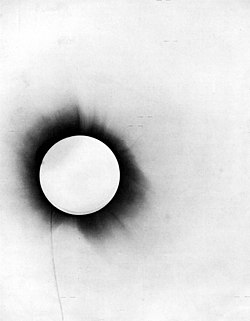I was about to do a little post about where we are in the General Relativity class. We’re about to start studying our first full non-trivial solution of Einstein’s equations. Then I had this feeling I’d done it before, so I looked, and indeed the very post I thought I’d do was first posted Feb. 13th 2008. So why not re-post it for your reading pleasure?
_________________________________________________
(First posted 13th Feb. 2008)
Well, only four weeks and change behind us in this course, and… the class (see here and here) is ready to understand this wonderful equation:

and all that it implies. What is it? It encodes the shape of spacetime around a spherical blob of mass of total mass M. No, don’t worry too much about the details, since this is not a lecture about General Relativity….. it is just nice (I hope) every now and again to get a look at the sorts of things we use in our day to day work. This “warped” spacetime encodes what we interpret as the gravitational field (in the old Newtonian language) due to a spherical (or, to a good approximation, almost spherical) mass. Like the sun, or the earth, or that tennis ball in the corner there*. It is an exact solution called the Schwarzschild solution, found by Karl Schwarzschild within just months of Einstein’s completion and publishing of his field equations for General Relativity. Decent (at time of writing) Wikipedia article here.
 The fun thing for me is that after the preparation we’ve been doing, the students are now equipped to study this and learn so much from it about how GR works, and about how Einstein’s physics differs from that of Newton. Within a short time in tomorrow’s lecture, the class will be appreciating (I hope) how to extract things like planetary orbits (including the relativistic corrections that give**, say, the precession of the perihelion of Mercury’s orbit, the bending of light by the sun (that was measured in the famous 1919 expeditions to observe the eclipse; Eddington’s announcement of the confirming result catapulted Einstein to super-stardom – a decent (at time of writing) Wikipedia article, from which I got the eclipse photo on the left, is here – and ultimately, the idea of curved spacetime began to slowly creep into the popular consciousness), and the “gravitational red shift” that electromagnetic radiation experiences when trying to escape from a massive body.
The fun thing for me is that after the preparation we’ve been doing, the students are now equipped to study this and learn so much from it about how GR works, and about how Einstein’s physics differs from that of Newton. Within a short time in tomorrow’s lecture, the class will be appreciating (I hope) how to extract things like planetary orbits (including the relativistic corrections that give**, say, the precession of the perihelion of Mercury’s orbit, the bending of light by the sun (that was measured in the famous 1919 expeditions to observe the eclipse; Eddington’s announcement of the confirming result catapulted Einstein to super-stardom – a decent (at time of writing) Wikipedia article, from which I got the eclipse photo on the left, is here – and ultimately, the idea of curved spacetime began to slowly creep into the popular consciousness), and the “gravitational red shift” that electromagnetic radiation experiences when trying to escape from a massive body.
Should be fun…!
-cvj
*Yes, the first two are in rotation, and strictly this solution is for stationary masses, but we can safely ignore that for now.
**Einstein predicted these effects using his theory, working with an approximate solution of his equations – Schwarzschild’s exact solution came later…
P.S. Later…much later… we’ll revisit this geometry and discover properties of black holes…. but that’s for, yes, later.

















That was a brilliant guess. I was trying to motivate a discussion on the comments; but yes kerr is fond of rotating stuff. I was hoping someone would mention axially-symmetric black holes or throw in some comments about momentum.
Hi,
I am not sure what you are saying, exactly. So it is hard to answer. Guessing at what you’re saying, I’d venture that you’re right if you’re saying that one should be wary of choices of coordinates and so forth. There are techniques for extracting physics that is very coordinate independent, by looking at things called curvature invariants and so forth. But that’s another story. Note that Kerr and Schwarzschild are talking about very different circumstances, by the way.
Cheers,
-cvj
It seems black hole descriptions vary based on the metric, and if kerr and Schwarzschild say different things in the classical regime, it would seem that the metric is doing something else besides measuring lengths . . . I’m sure I might just be thinking about this wrong . .